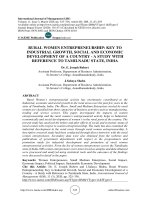Economic growth and economic development 378
Bạn đang xem bản rút gọn của tài liệu. Xem và tải ngay bản đầy đủ của tài liệu tại đây (106.56 KB, 1 trang )
Introduction to Modern Economic Growth
Exercise 7.3. The key equation of the calculus of variations is the Euler-Legrange
equation, which characterizes the solution to the following problem (under similar
regularity conditions to those of Theorem 7.2):
Z t1
F (t, x (t) , x˙ (t)) dx
max
x(t)
0
subject to x (t) = 0. Suppose that F is differentiable in all of its arguments and
an interior continuously differentiable solution exists. The so-called Euler-Legrange
equation, which provides the necessary conditions for an optimal solution, is
∂F (t, x (t) , x˙ (t)) ∂ 2 F (t, x (t) , x˙ (t))
−
= 0.
∂x (t)
∂ x˙ (t) ∂t
Derive this equation from Theorem 7.2. [Hint: define y (t) ≡ x˙ (t)].
Exercise 7.4. This exercise asks you to use the Euler-Legrange equation derived in
Exercise 7.3 to solve the canonical problem that motivated Euler and Legrange, that
of finding the shortest distance between two points in a plane. In particular, consider
a two dimensional plane and two points on this plane with coordinates (z0 , u0 ) and
(z1 , u1 ). We would like to find the curve that has the shortest length that connects
these two points. Such a curve can be represented by a function x : R → R such that
u = x (z), together with initial and terminal conditions u0 = x (z0 ) and u1 = x (z1 ).
It is also natural to impose that this curve u = x (z) be smooth, which corresponds
to requiring that the solution be continuously differentiable so that x0 (z) exists.
To solve this problem, observe that the (arc) length along the curve x can be
represented as
A [x (z)] ≡
Z
z2
z1
q
1 + [x0 (z)]2 dz.
The problem is to minimize this object by choosing x (z).
Now, without loss of any generality let us take (z0 , u0 ) = (0, 0) and let t = z to
transform the problem into a more familiar form, which becomes that of maximizing
Z t1 q
1 + [x0 (t)]2 dt.
−
0
Prove that the solution to this problem requires
Ê
Ă
ÂÔ
d x0 (t) 1 + (x0 (t))2
= 0.
dt
364









